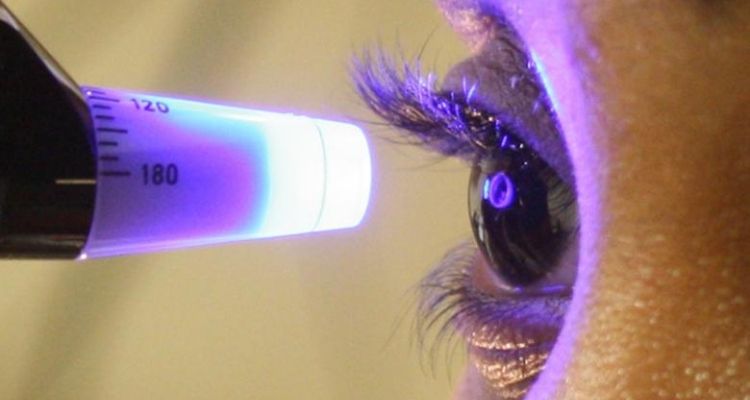

IOP eye pressure test ( Intraocular Pressure ) is the measurement of the pressure inside the eye. Applanation tonometry is a procedure performed to determine the intraocular pressure (IOP) or eye pressure.
Eye pressure is the pressure that the fluid inside the eye exerts outwards. This fluid is called Aqueous Humour. This pressure is important to maintain the shape of the eyeball. It also helps to keep it functioning normally.
The normal intraocular pressure is between 10 – 21 millimeters of mercury. Sometimes, the pressure can be lower or higher than this and it could still be considered normal.
When there is high eye pressure, we get a condition called glaucoma. There are many risk factors which we look into when diagnosing a patient with glaucoma. But, having high eye pressure is the most important risk factor to cause glaucoma.
The eye pressure test measurement could be higher than the normal intraocular pressure and your doctor could still say that you dont have glaucoma. We then call it ‘Ocular Hypertension. On the other hand, if your eye pressure test measurement could be below 21 millimeters of mercury and your doctor could still say that you have glaucoma. We then call it ‘Low tension Glaucoma’.
The other types of glaucoma are Primary open-angle glaucoma and Narrow-angle glaucoma. There are a few other types as well which are much less common than these.
There are a few eye pressure machines by which we can do the eye pressure test.
The most accurate of these is an instrument called Applanation Tonometry. An eye pressure test is done as a part of a routine eye examination. Before we do this test we have to instill certain eye drops which numb the eye. We then insert a dye into the eye. These drops and the dye helps inaccurate measurement of the eye pressure.
In applanation tonometry, the intraocular pressure is nothing but the force required to flatten (applanation) a constant area of the cornea. The applanation tonometer probe makes contact with the cornea. That is why the numbing drops are put into the eyes just before this test.
In many eye hospitals, one may also find an eye pressure machine called an air puff tonometer. This machine throws out a puff of air and thus the name. Many of our patients ask us just before we are about to check the pressure whether it's going to go “puff”. At Eye Solutions, we have both these machines. We routinely use the applanation tonometer, as it is the gold standard for performing the eye pressure test.
It is easy to understand that an eye pressure test at home is not possible when one uses applanation tonometry. There are, however, a few eye pressure machines like the Perkins tonometer which can be used for eye pressure tests at home. There are a few outdated pressure monitors too like the Shiotz tonometer. These are however hardly used these days.
There are a few things that can affect eye pressure. The most important of these is corneal thickness. Corneal thickness is measured by an instrument called pachymetry. When we find high eye pressures during a routine eye check-up we measure the corneal thickness.
A thicker cornea means we record a higher pressure. The pressure recorded is higher than the real eye pressure. Similarly, a thinner cornea means we record a lower pressure. The pressure recorded is lower than the real eye pressure. There is a formula which we use to adjust the eye pressure readings based on the corneal thickness readings.
This pressure of the eye should be controlled to save sight. In sight-threatening eye diseases such as glaucoma, this pressure increases. Glaucoma can cause asymptomatic and irreversible loss of vision if poorly treated or neglected. This vision loss occurs due to damage to the optic nerve.
The effect of glaucoma treatment on eye pressure may not always be constant. Thus the eye pressure needs to be regularly measured. Hence, the eye pressure test is an integral part of a complete eye examination. It is also important during regular follow-ups for all glaucoma patients.
As the pressure increases the optic nerve of the eye very gradually gets damaged. This damage leads to gradual loss of vision.
The procedure takes about 1 min for both eyes.
Eye pressure can be controlled by glaucoma eye drops or by glaucoma surgery. Over the past few years, the efficacy of glaucoma eye drops has increased. This has led to a reduced need to perform glaucoma surgeries.